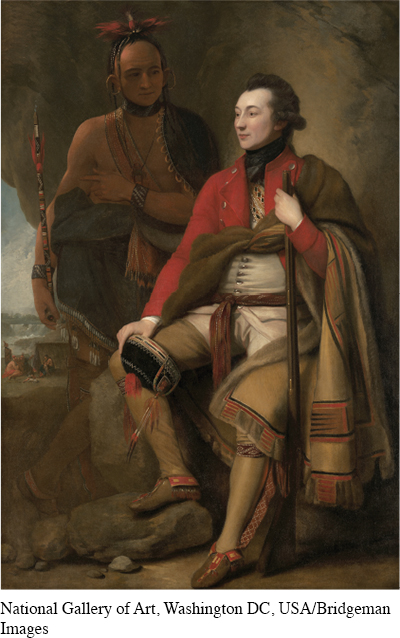Recruiting Supporters

Men who took up arms against the British before independence was declared and the women who supported them clearly demonstrated their commitment to the patriot cause. In some colonies, patriots organized local committees, courts, and assemblies to assume governance should British officials lose their authority. At the same time, white servants and enslaved blacks in Virginia who fled to British ships or marched with Lord Dunmore made their loyalties known as well. Some Indians, too, declared their allegiance early in the conflict. In May 1775, Colonel Guy Johnson, the British superintendent for Indian affairs, left Albany, New York, and sought refuge in Canada. He was accompanied by 120 British loyalists and 90 Mohawk warriors led by their mission-educated chief, Joseph Brant (Thayendanegea).
The Continental Congress, like Johnson, recognized the importance of Indians to the outcome of any colonial war. It appointed commissioners from the “United Colonies” to meet with representatives of the Iroquois Confederacy in August 1775. While Brant’s group of Mohawk warriors were already committed to the British, some Oneida Indians, influenced by missionaries and patriot sympathizers, wanted to support the colonies. Others, however, urged neutrality, at least for the moment.
Once independence was declared, there was far more pressure to choose sides. The stance of political and military leaders and soldiers was clear. But to win against Great Britain required the support of a large portion of the civilian population as well. As battle lines shifted back and forth across New England, the Middle Atlantic region, and the South, civilians caught up in the fighting were faced with difficult decisions.
Many colonists who remained loyal to the king found safe haven in cities like New York, Newport, and Charleston, which remained under British control throughout much of the war. Loyalist men were welcomed by the British army. Still, those who made their loyalist sympathies clear risked a good deal. When British troops were forced out of cities or towns they had temporarily occupied, many loyalists faced harsh reprisals. Patriots had no qualms about invading the homes of loyalists, punishing women and children, and destroying or confiscating property.
Many loyalists were members of the economic and political elite. Others came from ordinary backgrounds. Tenants, small farmers, and slaves joined the loyalist cause in defiance of their landlords, large property owners, and wealthy planters. Many poorer loyalists lived in the Hudson valley, their sympathy for the British heightened by the patriot commitments of the powerful men who controlled the region. When the fighting moved south, many former Regulators also supported the British, who challenged the domination of patriot leaders among North Carolina’s eastern elite.
Explore
For images of African Americans’ varied responses to the war, see Documents 6.2 and 6.3.
Perhaps most important, the majority of Indian nations ultimately sided with the British. The Mohawk, Seneca, and Cayuga nations in the North and the Cherokee and Creek nations in the South were among Great Britain’s leading allies. Although British efforts to limit colonial migration, such as the Proclamation Line of 1763, had failed, most Indian nations still believed that a British victory offered the only hope of ending further encroachments on their territory.
Exploring American HistoriesPrinted Page 179
Chapter Timeline